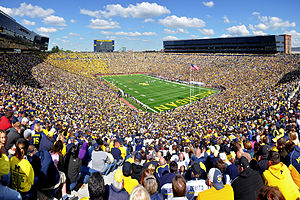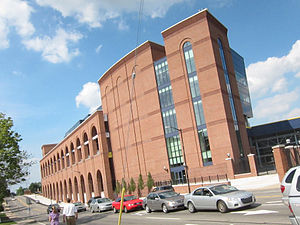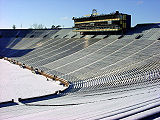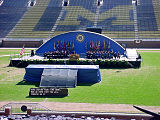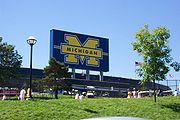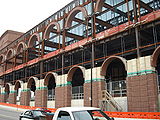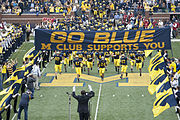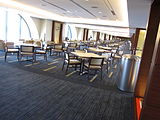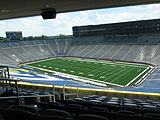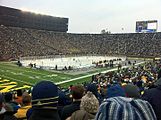- Michigan Stadium
-
Michigan Stadium "The Big House"
Michigan Stadium on September 17, 2011Location 1201 S. Main St. Ann Arbor, Michigan 48104-3722 Coordinates 42°15′57″N 83°44′55″W / 42.26583°N 83.74861°WCoordinates: 42°15′57″N 83°44′55″W / 42.26583°N 83.74861°W Broke ground September 12, 1926[1] Opened October 1, 1927[2] Renovated 2010 Expanded 1928, 1949, 1955, 1992, 1998, 2010 Owner University of Michigan Operator University of Michigan Surface FieldTurf (2003–present)
Natural grass (1991–2002)
Artificial turf (1969–1990)
Natural grass (1927–1968)Construction cost $950,000
($12 million in 2011 dollars[3])Architect Bernard L. Green General Contractor James Leck Company[4] Capacity 72,000 (1927)
85,752 (1928–1948)
97,239 (1949–1954)
101,001 (1955–1972)
101,701 (1973–1991)
102,501 (1992–1997)
107,501 (1998–2007)
106,201 (2008–2009)
109,901 (2010–present)Record attendance 114,804 (2011-09-10) Tenants Michigan Wolverines (NCAA) (1927–present) Michigan Stadium, nicknamed "The Big House,"[5] is the football stadium for the University of Michigan in Ann Arbor, Michigan. Michigan Stadium was built in 1927 at a cost of $950,000 and had an original capacity of 72,000. Before playing football at the stadium, the Wolverines played on Ferry Field. Michigan Stadium is the largest stadium in the United States with an official capacity of 109,901.[6] The football game attendance often exceeds 111,000 when band members, stadium staff, and others are added. On September 10, 2011, 114,804 attended a game at Michigan Stadium between Michigan and the Notre Dame Fighting Irish, the largest crowd to see a college football game since 1948 and an NCAA single-game record. The current NCAA single-season average home attendance record was 111,175 per game set in 1999 at the stadium.[7]
Michigan Stadium is the third largest stadium in the world and the 31st largest sports venue including auto racing and horse racing tracks, among others.[8] The one "extra seat" in Michigan Stadium is said to be reserved for former athletic director Fritz Crisler, although its location is not specified.[9] Every home game since November 8, 1975 has drawn a crowd in excess of 100,000, an active streak of more than 200 contests.[10] "Football Saturdays" in Ann Arbor have a profound effect on the city, dramatically increasing traffic and business at local establishments. The size of the crowd in the stadium nearly matches the city's population of 114,000.
Michigan Stadium was designed with footings to allow the stadium's capacity to be expanded beyond 100,000. According to the University of Michigan Library's and Athletics Department's history of the stadium, Fielding Yost envisioned a day where 150,000 seats would be needed. To keep construction costs low at the time, the decision was made to build a smaller stadium than Yost envisioned but to include the footings for future expansion.[11]
Michigan Stadium is the site of the University of Michigan's main graduation ceremonies; renovations in April 2008 caused that year's ceremony to be moved to the Diag.[12]
On December 11, 2010, the "Cold War II", a Michigan versus Michigan State hockey game, took place at Michigan Stadium. The event was officially called "The Big Chill at the Big House", and over 100,000 tickets had been sold by May 6, 2010, when sales to the general public were stopped. The remaining seats were set aside for students. The attendance for the game was 104,073, smashing the previous record for a hockey game by nearly 25,000.
The first night football game in Michigan Stadium history occurred on September 10, 2011, versus Notre Dame.
Contents
History
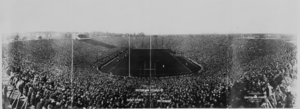 Formal dedication of the new Michigan Stadium, October 22, 1927, against Ohio State University
Formal dedication of the new Michigan Stadium, October 22, 1927, against Ohio State University
Michigan Stadium's size is not entirely apparent to outside observers, as it is constructed partially below grade, leaving only the upper 20 rows (in most sections) visible from the outside. The stadium's original capacity was 72,000, but Fielding Yost made certain to install footings that could allow for expansion up to 200,000 seats. Initially, all seating consisted of wooden bleachers. These were replaced with permanent metal seating in 1949 by Crisler, who was athletic director at the time. Longtime radio announcer Bob Ufer dubbed Michigan Stadium "The hole that Yost dug, Crisler paid for, Canham carpeted, and Schembechler fills every cotton-pickin' Saturday afternoon."[13] Since 1975, the stadium has held over 100,000 fans for every home game.[14] The game against Indiana University on October 25, 1975 was the last sub-100,000 attendance home game for Michigan.[14][15] Michigan's game versus Ball State University on November 4, 2006, was the 200th consecutive crowd of over 100,000 fans.[16] Traditionally, when the game's attendance is announced, the public address announcer (historically Howard King) thanks the fans for "being part of the largest crowd watching a football game anywhere in America".[17]
On October 1, 1927, Michigan played Ohio Wesleyan in the first game at Michigan Stadium, prevailing easily, 33–0. The new stadium was then formally dedicated three weeks later in a contest against Ohio State on October 22. Michigan had spoiled the formal dedication of Ohio Stadium in Columbus five years earlier and was victorious again, besting the Buckeyes 21–0 before a capacity crowd of 84,401. In 1930, electronic scoreboards were installed, making the stadium the first in the United States to use them to keep the official game time.[10]
From 1927 to 1968, the stadium's field was covered in natural grass. This was replaced with TartanTurf in 1969 to give players better traction. However, this surface was thought to be unforgiving on players' joints, and the stadium returned to natural turf in 1991. This too became problematic, as the field's below-surface location near the water table made it difficult for grass to permanently take root. The field was converted to FieldTurf, an artificial surface designed to give grass-like playing characteristics, in 2003.[18]
Before 1968, the football field had a policy of "No women or children allowed on the field." Sara Krulwich, now a photojournalist for The New York Times, was the first woman on the field.[19]
On September 9, 2006, attendees of Michigan's football game against the Central Michigan Chippewas endured the first weather delay in the stadium's history after lightning struck nearby during the first quarter.[20] The game was delayed for approximately one hour.
On March 11, 2008, as part of the settlement terms of a lawsuit filed against the university pursuant to the Americans with Disabilities Act, the university announced that the official capacity of the stadium would be reduced to accommodate additional wheelchair-accessible seating beginning with the 2009 season.[21]
2010 renovation
On June 21, 2007, the University's Board of Regents approved a $226 million renovation and expansion project for Michigan Stadium which was completed in 2010. The project includes replacement of some bleachers, widening of aisles and individual seats, installing hand rails, and the addition of a new press box, 83 luxury boxes, and 3,200 club seats. The renovation plan garnered opposition from students, alumni, and fans around the country, which waned as the renovation neared external completion.[22]
A disabled-veterans group filed a federal lawsuit against the university on April 17, 2007, alleging that the design of the project did not meet federal standards for wheelchair-accessible seating.[23] In March 2008, the case was settled, with the university agreeing to add more accessible seating in place of current seating during the course of the renovation.
Michigan Stadium was rededicated on September 4, 2010, before Michigan's first home football game of the 2010 season against the University of Connecticut,[24] with a listed capacity of 109,901.[6]
Lights and night games
After the renovation, the stadium continued to lack lights, although platforms for temporary lights were included in the design. In September 2010, a few days after the rededication, the University of Michigan's Board of Regents approved a plan to add permanent lights, at a cost of $1.8 million. The lights were first used at the men's hockey game on December 11, 2010. The first night football game in the stadium was on September 10, 2011, when the Wolverines defeated the Notre Dame Fighting Irish 35–31.[25]
Attendance records
On September 10, 2011, Michigan Stadium drew its largest attendance for a football game to date. A crowd of 114,804 saw Michigan defeat Notre Dame, 35–31, setting a post-1948 NCAA collegiate football attendance record. (A 1927 Notre Dame – Southern California game at Soldier Field in Chicago, prior to NCAA record keeping for attendance, drew an estimated 117,000 – 123,000.)[26][27][28]
In 2004, Michigan set an NCAA record for average attendance at home games, with an average of 111,025 fans.[14]
With an attendance of 104,173, "The Big Chill at the Big House" set the record attendance for a hockey game.[29] The previous record of 77,803 was set in the opening game of the 2010 IIHF World Championship on May 7, 2010 at Veltins-Arena, a retractable-roof soccer stadium in Gelsenkirchen, Germany.[30]
Highest Attendance at Michigan Stadium Rank Attendance Date Game result 1 114,804 Sept. 10, 2011 Michigan 35, Notre Dame 31 2 113,718 Nov. 19, 2011 Michigan 45, Nebraska 17 3 113,090 Sept. 4, 2010 Michigan 30, Connecticut 10 4 113,065 Oct. 9, 2010 Michigan 17, Michigan State 34 5 112,784 Oct. 16, 2010 Michigan 28, Iowa 38 6 112,276 Nov. 20, 2010 Michigan 28, Wisconsin 48 7 112,118 Nov. 22, 2003 Michigan 35, Ohio State 21 8 112,115 Oct. 29, 2011 Michigan 36, Purdue 14 9 111,941 Nov. 17, 2007 Michigan 3, Ohio State 14 10 111,726 Sept. 13, 2003 Michigan 38, Notre Dame 0 Gallery
-
2009 team enters Stadium under the M Club banner as the Michigan Marching Band salutes.
-
View during the The Big Chill at the Big House showing newly added lights for night games.
References
- ^ Workmen Swarm Michigan Stadium. Ludington Daily News – Sep 13, 1926
- ^ Bruce Madej; Rob Toonkel; Mike Pearson (1 November 1997). Michigan: champions of the West. Sports Publishing LLC. pp. 79–. ISBN 978-1-57167-115-8. http://books.google.com/books?id=fd87BHQ4VrkC&pg=PT79. Retrieved 26 September 2011.
- ^ Consumer Price Index (estimate) 1800–2008. Federal Reserve Bank of Minneapolis. Retrieved December 7, 2010.
- ^ John Kryk (25 November 2004). Natural enemies: major college football's oldest, fiercest rivaly—Michigan vs. Notre Dame. Taylor Trade Publications. pp. 106–. ISBN 978-1-58979-090-2. http://books.google.com/books?id=IBzFV5QGSv0C&pg=PA106. Retrieved 26 September 2011.
- ^ "'Big Ten Icons' to Count Down Conference's All-Time Top 50 Student-Athletes: Iconic broadcaster Keith Jackson to host the series launching this fall". CBS Interactive. 2010-03-04. http://www.bigten.org/genrel/030410aaa.html. Retrieved 2010-03-27.
- ^ a b "Big House Again! Michigan Stadium Capacity Announced at 109,901" (Press release). mgoblue.com. 14 July 2010. http://www.mgoblue.com/sports/m-footbl/spec-rel/071410aad.html. Retrieved 2011-06-07.
- ^ Gary Johnson (22 February 2010). "NCAA football attendance plateaus after record run". The NCAA News (National Collegiate Athletic Association). http://www.ncaa.org/wps/wcm/connect/ncaa/ncaa/ncaa+news/ncaa+news+online/2010/association-wide/ncaa+football+attendance+plateaus+after+record+run_02_22_10_ncaa_news. Retrieved 2010-07-13.
- ^ "Stadium Lists: 100,000+ Stadiums". www.worldstadiums.com. http://www.worldstadiums.com/stadium_menu/stadium_list/100000.shtml. Retrieved 2006-01-11.
- ^ "Facilities: Michigan Stadium". mgoblue.com. http://www.mgoblue.com/facilities/michigan-stadium.html. Retrieved 2011-06-07.
- ^ a b "Stadium History". The University of Michigan. http://www.umich.edu/stadium/history/. Retrieved 2011-06-07.
- ^ "Once Again the Biggest House, 1998". Bentley Historical Library. 15 April 2007. http://bentley.umich.edu/athdept/stadium/stadtext/stad1998.htm. Retrieved 2011-06-07.
- ^ Jillian Bogater (28 May 2008). "Keynote Woodruff shares life lessons, hope". The University Record Online (University of Michigan New Service). http://www.ur.umich.edu/0708/Apr28_08/00.php. Retrieved 2011-06-07.
- ^ Dan Feldman (20 April 2009). "Through transition, class of '09 had its ups, but mostly downs". The Michigan Daily (michigandaily.com). http://www.michigandaily.com/search/apachesolr_search/canham%20carpeted. Retrieved 2011-06-07.
- ^ a b c "The Michigan Stadium Story: Michigan Stadium Attendance Records". Bentley Historical Library. 15 January 2011. http://bentley.umich.edu/athdept/stadium/stadtext/mattend.htm. Retrieved 2011-06-07.
- ^ "1975 Football Team". Bentley Historical Library. 31 march 2007. http://bentley.umich.edu/athdept/football/fbteam/1975fbt.htm. Retrieved 2011-06-07.
- ^ "For 200th Straight Game, 100,000 Will Pack Michigan Stadium". CSTV.com. Associated Press (CBS College Sports). 1 November 2006. http://www.cstv.com/sports/m-footbl/stories/110106acp.html. Retrieved 2011-06-07.
- ^ Steve Rom, Rod Payne (2006). Centered by a Miracle. Sports Publishing. p. 45. ISBN 9781596701458.
- ^ Michael Nisson (August 11, 2003). "FieldTurf receives praise from Carr". The Michigan Daily (michigandaily.com). http://www.michigandaily.com/content/fieldturf-receives-praise-carr. Retrieved 2011-06-07.
- ^ Sara Krulwich (22 May 2009). "Essay: "No Women" Was No Barrier". The New York Times (NYTimes.com). http://lens.blogs.nytimes.com/2009/05/22/essay-first-woman-on-the-field/. Retrieved 2010-05-12.
- ^ Dave Wharton (1 January 2007). "Michigan: The season". Los Angeles Times (LATimes.com): p. S-12. http://articles.latimes.com/2007/jan/01/sports/sp-michseason1. Retrieved 2011-06-07.
- ^ Gabe Nelson (10 March 2008). "Michigan Stadium lawsuit settled". michigandaily.com. http://www.michigandaily.com/content/university-reaches-settlement-big-house-lawsuit. Retrieved 2011-06-07.
- ^ Lynn Monson (14 September 2007). "U-M professors urge reconsideration of Michigan Stadium expansion". Ann Arbor News (Mlive.com). http://blog.mlive.com/annarbornews/2007/09/um_professors_urge_reconsidera.html. Retrieved 2011-06-07.
- ^ Andy Kroll (19 November 2007). "Despite lawsuit, complaints, stadium construction begins". The Michigan Daily (michigandaily.com). http://www.michigandaily.com/content/despite-lawsuit-complaints-stadium-construction-begins. Retrieved 2011-06-07.
- ^ "Michigan Stadium Rededication-September 4, 2010". University of Michigan Athletics. http://www.mgoblue.com/sports/m-footbl/spec-rel/stadium-rededication.html. Retrieved 2011-06-07.
- ^ "Permanent Lights to be Installed at Michigan Stadium" (Press release). University of Michigan Athletics. 16 September 2010. http://www.mgoblue.com/sports/m-footbl/spec-rel/091610aan.html. Retrieved 2011-06-16.
- ^ Ford, Liam T. A. (2009). Soldier Field: A Stadium and its City. University of Chicago Press. pp. 89–90. ISBN 0226257061, 9780226257068. http://books.google.com/books?id=Lg0jIiGg4HUC&pg=PA90&lpg=PA90&dq=notre+dame+navy+1928+SOldier+Field#v=onepage&q=notre%20dame%20navy%201928%20SOldier%20Field&f=false.
- ^ "Stadium History". SoldierField.net. http://www.soldierfield.net/content/stadium-history. Retrieved 2011-06-07.
- ^ NCAA attendance records. (PDF) . Retrieved on 2011-09-26.
- ^ "Highest attendance for an ice hockey match". Guinness World Records. http://www.guinnessworldrecords.com/records-6000/highest-attendance-for-an-ice-hockey-match/. Retrieved 2011-09-06.
- ^ Alan Adams (7 May 2010). "Historic win for Germany". International Ice Hockey Federation. http://www.iihf.com/channels10/iihf-world-championship-wc10/news/news-singleview-world-championship/article/historic-win-for-germany.html. Retrieved 2010-07-26.
External links
- Official Michigan Stadium information page
- Michigan Stadium Renovation
- The Michigan Stadium Story – Bentley Historical Library, University of Michigan Athletics History
Michigan Wolverines football Venues Ann Arbor Fairgrounds (1883–1892) • Regents Field (1893–1905) • Ferry Field (1906–1926) • Michigan Stadium (1927–present)
Bowls & rivalries Bowl games • Little Brown Jug (Minnesota) • Notre Dame • Ohio State • Paul Bunyan Trophy (Michigan State)
Culture & lore People Head coaches • Trainers • Players • All-Americans • Hall of Honor • Statistical leaders
Seasons 1879 • 1880 • 1881 • 1882 • 1883 • 1884 • 1885 • 1886 • 1887 • 1888 • 1889 • 1890 • 1891 • 1892 • 1893 • 1894 • 1895 • 1896 • 1897 • 1898 • 1899 • 1900 • 1901 • 1902 • 1903 • 1904 • 1905 • 1906 • 1907 • 1908 • 1909 • 1910 • 1911 • 1912 • 1913 • 1914 • 1915 • 1916 • 1917 • 1918 • 1919 • 1920 • 1921 • 1922 • 1923 • 1924 • 1925 • 1926 • 1927 • 1928 • 1929 • 1930 • 1931 • 1932 • 1933 • 1934 • 1935 • 1936 • 1937 • 1938 • 1939 • 1940 • 1941 • 1942 • 1943 • 1944 • 1945 • 1946 • 1947 • 1948 • 1949 • 1950 • 1951 • 1952 • 1953 • 1954 • 1955 • 1956 • 1957 • 1958 • 1959 • 1960 • 1961 • 1962 • 1963 • 1964 • 1965 • 1966 • 1967 • 1968 • 1969 • 1970 • 1971 • 1972 • 1973 • 1974 • 1975 • 1976 • 1977 • 1978 • 1979 • 1980 • 1981 • 1982 • 1983 • 1984 • 1985 • 1986 • 1987 • 1988 • 1989 • 1990 • 1991 • 1992 • 1993 • 1994 • 1995 • 1996 • 1997 • 1998 • 1999 • 2000 • 2001 • 2002 • 2003 • 2004 • 2005 • 2006 • 2007 • 2008 • 2009 • 2010 • 2011
National championshipFootball stadiums of the Big Ten Conference Legends Division Kinnick Stadium (Iowa) • Michigan Stadium (Michigan) • Spartan Stadium (Michigan State) • TCF Bank Stadium (Minnesota) • Memorial Stadium (Nebraska) • Ryan Field (Northwestern)
Leaders Division Memorial Stadium (Illinois) • Memorial Stadium (Indiana) • Ohio Stadium (Ohio State) • Beaver Stadium (Penn State) • Ross–Ade Stadium (Purdue) • Camp Randall Stadium (Wisconsin)
College football venues in Michigan Division I
FBSBig Ten Michigan Stadium (Michigan) • Spartan Stadium (Michigan State)
MAC Division II GLIAC Adams Field (Wayne State) • Hantz Stadium (Northwood) • Lubbers Stadium (Grand Valley State) • Muddy Waters Stadium (Hillsdale) • Sherman Field (Michigan Tech) • Superior Dome (Northern Michigan) • Top Taggart Field (Ferris State) • Wickes Stadium (Saginaw Valley State)
Division III MIAA Categories:- College football venues
- Michigan Wolverines football venues
- Outdoor ice hockey venues in the United States
- Buildings and structures completed in 1927
Wikimedia Foundation. 2010.

